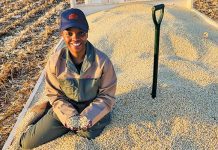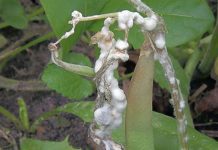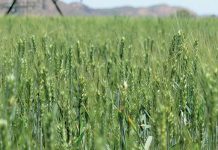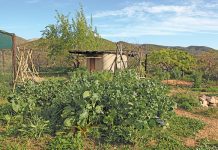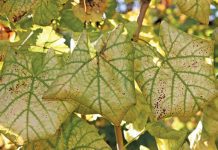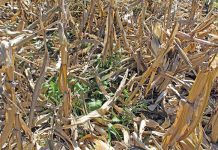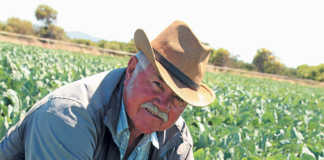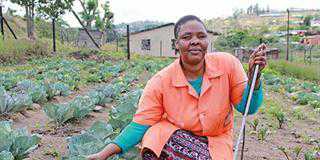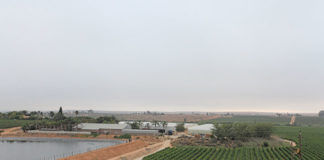Hydroponics in tunnels has completely revolutionised lettuce production by allowing producers to supply the market throughout the year. In addition, the controlled environment shortens the production period and results in a higher-quality product and higher yields than are possible with conventional farming methods.
Duncan and Karen Napier identified the benefits of this type of production eight years ago and decided to rent about 2ha of land just outside Hermanus to start producing lettuce hydroponically. They decided to use a closed hydroponics system ( nutrient solution recycling system) with gravel chips as growth medium. This system is much more nutrient- and water-efficient than open systems where the nutrient solution is continually drained to waste. The system consists of 40m to 50m plant beds built using hydroponics liners on a 3% to 5% slope.
Plant beds should not exceed 50m as this would have a negative impact on water flow, says Karen. She adds that the bed can be used for up to five years before it needs relining. The slope allows for gravitational flow of the nutrient solution from the upper end to the lower end of the beds, after which it is collected in a sump tank before being recycled.
The use of gravitation makes the gravel-flow technique much more energy-efficient than using a pump for the whole recycling process. The nutrient solution is chlorinated to sterilise it where it is collected at the bottom sump. Karen explains that there is a much higher chance of plants being scorched if the solution is chlorinated just before entering the beds than if chlorine is added to the nutrient solution as it exits. She adds that the chlorine- dosing levels are checked daily, as chlorine is very unstable and quickly dissipates from the water after treatment.
Equipment and power requirements
Karen says that besides Eskom power, a generator is used, as power failures can have a detrimental impact on production. “ Hydroponics is an extremely sensitive production system. Plants would probably last only a day without water,” she says. The solenoid taps, which control the gravity feed of the nutrient solution, automatically switch on at 6am in summer and around 8am in winter, and then switch on and off throughout the day to create a pulse effect through the beds, before finally switching off in the late afternoon.
Black polyethylene pipes are used to transport the water around the farm. These pipes are buried underneath the sand to keep the water nutrient solution from becoming too warm, which would result in growth stress. Wires keep the pipes in place where they enter plant beds. The lined beds are filled with gravel, an inorganic growth medium. Organic material, such as wood, can only be used for one or two seasons before it decomposes. Inorganic material, however, can be sterilised and re-used for many seasons.
The Napiers’ cleaning and addition of new gravel is based on the physical appearance of the beds. “There is currently a lot of debate on whether gravel should be cleaned annually or every other year. We change and clean the gravel when we observe uneven plant growth and when there is a build- up of dirt in the plant bed,” Karen says. “Organic material also releases nutrients as it decomposes, whereas inorganic material does not have any effect on the production environment. Inorganic media simply hold the plants in place, while nutrients are supplied through the water.” Another huge advantage is that inorganic material has a lower water-holding capacity than organic material.
The larger pores between particles mean that water drains faster and there is better aeration of plant roots. The Napiers specifically decided on gravel because it is much cheaper than most other inorganic media such as perlite, rock wool and volcanic rock. The same nutrient solution is used in all the lettuce production stages on the farm.
This best-fit-for-all balanced nutrition approach, developed by Duncan, makes production much easier and less technical than it would be if a separate programme was used for each growth stage. Monitoring and maintenance Water pH and electrical conductivity (EC ) are monitored regularly and new nutrients and water are added to maintain the pH and EC at suitable levels.
The Napiers have found that in their system, the EC should be maintained at between 1,2 and 1,5 in summer and around 1,8 in winter. A water pH of below 7, ideally between 5,8 and 6,8 is ideal, as plants have difficulty absorbing certain nutrients at a pH level above 7 and below 5. The Napiers initially used white nets, but have since replaced these with black nets. Karen explains that the white nets were recommended because they eliminate certain harmful UV frequencies, but also increase production temperature in summer, which is detrimental to plant growth.
Production temperatures are predicted to rise in any case due to global warming, and the black nets are therefore more suitable for production. However, some salads, such as red lettuce, have colouring difficulties under the black nets, according to Karen. The production of seedlings from seed is contracted out, as this allows the Napiers to concentrate on growing out the plants. The Napiers give the nursery a weekly list (governed by market demand) of what they need for production.
Seedlings are then planted daily into the hydroponics system. Depending on the type of herb or salad, plants take around 3,5 weeks to mature in summer, while production slows down to between seven to eight weeks in winter. According to Karen, this slower growth in winter fits the demand curve, which is also lower in winter.
Karen says that production under hydroponics is extremely capital and labour-intensive. It also requires constant attention to detail, as one small mistake can lead to huge production losses. Growing hydroponically is one thing, but marketing the final product is another. Karen suggests that potential producers should have a ready market for their product and sufficient knowledge of this type of production before they start, because it is so capital-intensive. Contact Karen Napier on 082 871 1068 or e-mail [email protected].

